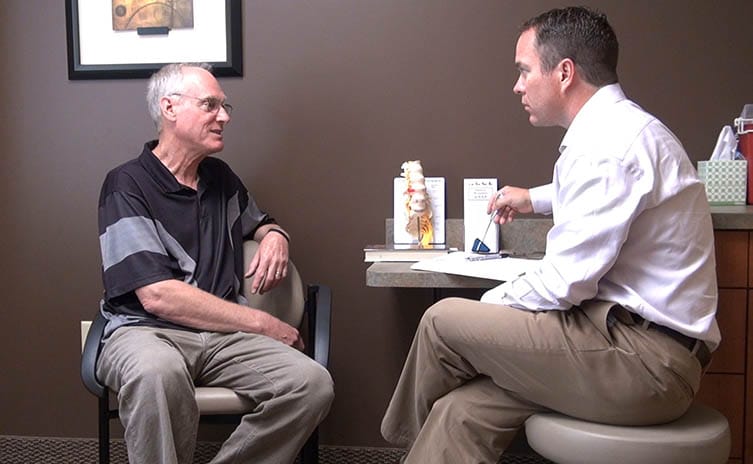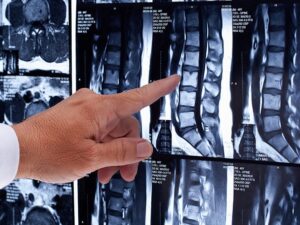Facet Joint Pain
 Facet joints are paired spinal joints found on the posterior aspect of the spine. There is one joint on each side of the spine at each cervical, thoracic, and lumbar level. These joints, along with spinal disks, help provide support and mobility during movement and each spinal vertebral level.
Facet joints are paired spinal joints found on the posterior aspect of the spine. There is one joint on each side of the spine at each cervical, thoracic, and lumbar level. These joints, along with spinal disks, help provide support and mobility during movement and each spinal vertebral level.
These joints are like other joints in the body with joint cartilage and a lubricating joint fluid called synovial fluid produced by a joint lining called the synovium. Facet joints have the same tissues as knees and hips.
Facet joint pain is spinal pain related to these joints in the cervical, thoracic, or lumbar spine. These pains are usually described as an ache or stiffness feeling and after often associated with spine muscle tenderness and stiffness. Symptoms can come and go. At times the symptoms are minimal but can flare with more moderate to severe activity.
Severe incapacitating pain is not typical of facet pain. In more advanced cases of facet arthritis, bone spurs can form and/or the joints enlarge and pinch spinal nerves or the spinal cord and cause radicular pain or spinal stenosis symptoms. including Myelopathy, or injury to the spinal cord, can occur if the joints in the neck or thoracic area enlarge enough to compress the spinal cord itself.
As with other joints in the body, osteoarthritis (“wear and tear”) is the most common cause of this painful joint condition. Other conditions such as rheumatoid arthritis, ankylosing spondylitis, trauma or whiplash, and stresses related to degenerative disk disease, scoliosis, or prior back surgery can also contribute to spinal joint pain.
In these conditions, inflammation and pain in the facets are most common in older populations as a degenerative process, but can also occur in younger people, particularly if there is a history of prior spine trauma including fracture or whiplash.
Symptoms
 Cervical facet joint pain can result in neck pain with radiation into the shoulder or shoulder blade area, and/or headache. Neck stiffness and muscle tenderness are also common. It is also common to experience sensations or sounds often described by patients as ‘grinding’, ‘popping’, ‘cracking’, ‘gravel’, or ‘sand paper’ in the neck or back. Cervical facet pain can cause pain when turning the head while driving or difficulty at night relaxing the neck when lying down.
Cervical facet joint pain can result in neck pain with radiation into the shoulder or shoulder blade area, and/or headache. Neck stiffness and muscle tenderness are also common. It is also common to experience sensations or sounds often described by patients as ‘grinding’, ‘popping’, ‘cracking’, ‘gravel’, or ‘sand paper’ in the neck or back. Cervical facet pain can cause pain when turning the head while driving or difficulty at night relaxing the neck when lying down.- Thoracic facet joint pain can cause middle back pain, usually, at the level of the shoulder blades or below.
- Lumbar facet joint pain can cause low back pain with radiation into the buttock, hip, or thigh. These neck and back pain symptoms are usually worse in the morning and improve within a few seconds to minutes after walking around and limbering up. The symptoms are also often worsened by prolonged sitting or standing and make standing upright out of a chair difficult, and again, typically improves with movement. Lumbar facet pain can also cause difficulty lying flat on one’s back. If the arthritis is causing a pinched nerve or spinal stenosis symptoms can include arm or leg pain, numbness, tingling, or muscle weakness.
- Most patients will have spinal tenderness overlying the affected areas. Pain is often aggravated by leaning back (extension) and/or twisting (rotation) of the neck or back and can be relieved by bending forward (flexion)
Diagnosing
Diagnosis is initially based upon a complete history and physical examination. Diagnostic imaging (X-ray, CT, and MRI) of the facets are often non-specific since visual evidence of joint arthritis (or facet hypertrophy) on diagnostic imaging is not always a correlating indicator of facet joint pain.
However, imaging can be utilized to evaluate for other spinal disorders which may create similar symptoms or identify a pinched nerve or spinal stenosis. After an appropriate period of conservative care with medication, physical therapy, and/or chiropractic, diagnostic facet block injections can be utilized to confirm suspected joint pain.
Treatments
The initial step of treatment is conservative care consisting of activity modification, stretching, physical therapy, chiropractic manipulation, and/or medications. Physical therapy consists of both active and passive treatments. These treatments are utilized to restore or improve spinal range of motion and muscle function. Physical therapy, an active treatment, consists of stretching and strengthening exercise activities.
Exercise is utilized to improve the strength of the supporting spinal muscles and restore normal spinal posture and range of motion. Passive treatment can include such things as ice, muscles rubs, electrical stimulation, ultrasound, traction, massage, and chiropractic manipulation which are used to relieve muscle tension and pain caused by the underlying joint pain.
Next, if symptoms persist, diagnostic facet injections can be performed to the facets to block pain in the joint area. If the procedure is successful in producing temporary pain relief the joint is confirmed as a cause of back pain. Finally, a rhizotomy (also called radiofrequency ablation or neurotomy) can be performed in an attempt to provide longer-lasting pain relief ranging from months to years, typically 6-18 months.
Longer-term, it is recommended that people stay physically active and participate in a daily exercise program in order to maintain spinal function and promote a healthy lifestyle.
Frequently Asked Questions
Osteoarthritis, rheumatoid arthritis, ankylosing spondylitis, trauma, and stresses related to degenerative disk disease or prior back surgery are the most common causes of facet joint pain.
Generally, facet joint pain symptoms can come and go. Due to the degenerative nature of the condition, or associated inflammation, trauma, and injury to the joints the underlying joint dysfunction will persist.
In spite of this, pain-free periods are often experienced along with frustrating periods of painful flares. Many people have minimal symptoms unless an aggravation occurs, such as by repeated heavy activity or a motor vehicle accident.
In addition to the medical treatments outlined above, home exercise, topical treatments with heat or ice, massage, stretching, and oral analgesics are patient-directed activities best utilized to manage facet joint symptoms.
Facet joints play a crucial role in spinal range of motion. When facet joints become dysfunctional due to arthritis or injury a loss of range of motion can be expected.
In more severe cases, the loss of range of motion can be significant due to the development of bone spurs or enlargement of joints themselves that cause a structural/mechanical limitation to the joint’s natural movement.
Therefore, patients are encouraged to manage their stiffness with stretches and exercises to perhaps improve, certainly maintain, and most importantly prevent further loss of range of motion.


 Cervical facet joint pain can result in neck pain with radiation into the shoulder or shoulder blade area, and/or headache. Neck stiffness and muscle tenderness are also common. It is also common to experience sensations or sounds often described by patients as ‘grinding’, ‘popping’, ‘cracking’, ‘gravel’, or ‘sand paper’ in the neck or back. Cervical facet pain can cause pain when turning the head while driving or difficulty at night relaxing the neck when lying down.
Cervical facet joint pain can result in neck pain with radiation into the shoulder or shoulder blade area, and/or headache. Neck stiffness and muscle tenderness are also common. It is also common to experience sensations or sounds often described by patients as ‘grinding’, ‘popping’, ‘cracking’, ‘gravel’, or ‘sand paper’ in the neck or back. Cervical facet pain can cause pain when turning the head while driving or difficulty at night relaxing the neck when lying down.